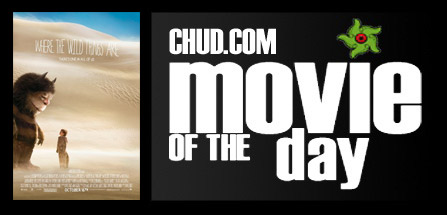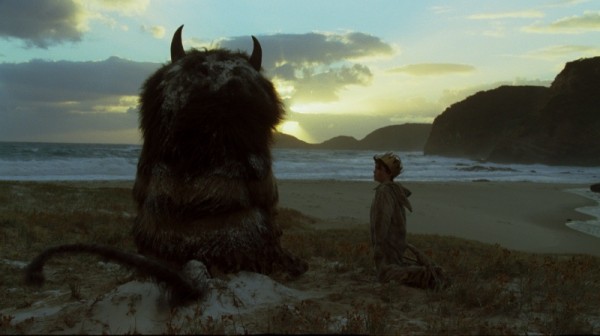The Film: Where The Wild Things Are (2009)
The Principles: Spike Jonze (Dir), Lance Acord (DP), K.K. Barrett (PD), Max Records, James Gandolfini, Catherine Keener, Lauren Ambrose, Catherine O’Hara, Forest Whitaker, Paul Dano, Chris Cooper
Written By: Spike Jonze & Dave Eggers
The Premise: Innovative director Spike Jonze collaborates with celebrated author Maurice Sendak to bring one of the most beloved books of all time to the big screen in “Where the Wild Things Are,” a classic story about childhood and the places we go to figure out the world we live in. The film tells the story of Max, a rambunctious and sensitive boy who feels misunderstood at home and escapes to where the Wild Things are. Max lands on an island where he meets mysterious and strange creatures whose emotions are as wild and unpredictable as their actions. The Wild Things desperately long for a leader to guide them, just as Max longs 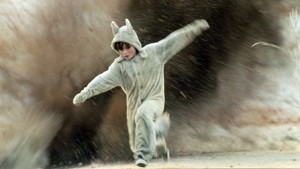 for a kingdom to rule. When Max is crowned king, he promises to create a place where everyone will be happy. Max soon finds, though, that ruling his kingdom is not so easy and his relationships there prove to be more complicated than he originally thought.
for a kingdom to rule. When Max is crowned king, he promises to create a place where everyone will be happy. Max soon finds, though, that ruling his kingdom is not so easy and his relationships there prove to be more complicated than he originally thought.
Is it any good? It’s entirely good. It’s masterful. It’s a breathtaking achievement at every level, saturated in a timeless wonder. It speaks to us in a language of joyful howls and melancholy faces, and uses each and every scene to capture some acute emotion or realization unique to childhood. The collaboration of Spike Jonze, Dave Eggers, and Maurice Sendak is something that borders on miraculous- the trio gracefully expand Sendak’s 338-word children’s tale into a feature film not by adorning it with additional story beats or cramming in mythology, but merely by swimming deeper in the same ponds of emotion and exuberance.
It’s impossible to overstate the exceptional control of Jonze’s filmmaking in Where The Wild Things Are. His hand-held camera is perfectly tuned to the rhythm of Max Record’s performance –or more specifically the mood 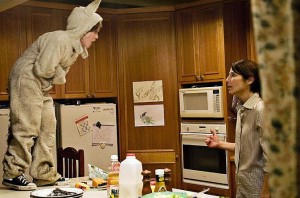 of Wild Thing Max– and it creates a perfect window into Max’s world. The chaos of Max chasing his dog, the quiet peeking around corners, the delicate affixing of a plastic bag to a stick, the panicked searching for an escape from a collapsed snow fort, tumbling through the trees with giant beasts, on and on and on… Jonze’s frame moves in flawless synchronicity with Max, as if tied in to his very chemistry- exploding with his adrenaline, growing lethargic with his sadness. This approach is effortlessly established in the film’s opening act as we meet Max, meet his increasingly distant Sister, meet his loving but stretched-thin Mother. Every aspect of Max’s world is rendered with a remarkable balance of specificity and universality- the magic hour photography and wood-paneled walls working to engage visual and emotional memory at the same time. The scale of the world feels as it should from the point of view of a nine-year-old boy, as does the jerky pace that bounces between chaos and quiet.
of Wild Thing Max– and it creates a perfect window into Max’s world. The chaos of Max chasing his dog, the quiet peeking around corners, the delicate affixing of a plastic bag to a stick, the panicked searching for an escape from a collapsed snow fort, tumbling through the trees with giant beasts, on and on and on… Jonze’s frame moves in flawless synchronicity with Max, as if tied in to his very chemistry- exploding with his adrenaline, growing lethargic with his sadness. This approach is effortlessly established in the film’s opening act as we meet Max, meet his increasingly distant Sister, meet his loving but stretched-thin Mother. Every aspect of Max’s world is rendered with a remarkable balance of specificity and universality- the magic hour photography and wood-paneled walls working to engage visual and emotional memory at the same time. The scale of the world feels as it should from the point of view of a nine-year-old boy, as does the jerky pace that bounces between chaos and quiet.
Then a nighttime tantrum sends our hero to the side of a lake, onto a small boat, across an ocean, and over to a world of giants. These beasts, these Wild Things, are a herd of neurotic, destructive, and loving creatures that are beautifully brought to life through muppetry and VFX. They have weight and mass and texture, and they leap, throw each other around, and crash about with unbelievable power. There are no shortcuts- the film 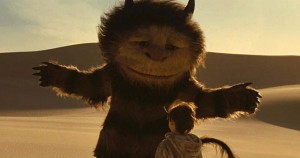 revels in capturing great leaps and bounces that seem utterly impossible, and establish that these aren’t delicate suits primped up for each shot. There’s a danger inherent and, by showing us immediately that the Wild Things are very real creatures capable of massive feats, the film tells us anything is possible. The richness does not end with the Wild Things though, as they live in a beautiful world of wood, sand, and stone. We see many different landscapes, genuinely inhabited without even a hint of a digital seam peaking in to ruin the fun. Trees burst into splinters and giant forts are erected out of thousands of branches that were clearly assembled in the very real world. CGI enhances here and there, but Where The Wild Things Are truly represents an all-time effort of actual blood-and-sweat production design. This is as good as place as any to also mention Karen O and Carter Burwell’s amazing score, which is similarly in tune with the manic and melancholy rhythm of Max, providing momentum and explosive bursts of excitement for the film. It’s another pitch-perfect layer of the craft that helps makes this a truly singular film.
revels in capturing great leaps and bounces that seem utterly impossible, and establish that these aren’t delicate suits primped up for each shot. There’s a danger inherent and, by showing us immediately that the Wild Things are very real creatures capable of massive feats, the film tells us anything is possible. The richness does not end with the Wild Things though, as they live in a beautiful world of wood, sand, and stone. We see many different landscapes, genuinely inhabited without even a hint of a digital seam peaking in to ruin the fun. Trees burst into splinters and giant forts are erected out of thousands of branches that were clearly assembled in the very real world. CGI enhances here and there, but Where The Wild Things Are truly represents an all-time effort of actual blood-and-sweat production design. This is as good as place as any to also mention Karen O and Carter Burwell’s amazing score, which is similarly in tune with the manic and melancholy rhythm of Max, providing momentum and explosive bursts of excitement for the film. It’s another pitch-perfect layer of the craft that helps makes this a truly singular film.
 Then of course there are the Wild Things, and the wonderful performances that bring them to life. Triumphant on-set muppeteering and physical performance is done great justice by performance that are no mere pajamas-and-paychecks studio voice overs as we find in most children’s films. Jonze put his Wild Thing actors on a stage and bounced them around, recording their exertions and improvisations. Thus the Wild Things do not feel like constructs- they feel like actual beings that Max has dreamed into existence. Even more importantly, Jonze, Eggers, and Sendak did not expand on these creatures as mere 1:1 metaphors. Certainly Gandolfini brings to life Max’s manic-depressive Id, while Ambrose’s K.W. stands in for Max’s sister, struggling with her own heartbreaking need to find herself without abandoning an emotional-hungry younger brother. But even as you break down the Wild Things as figures in Max’s life, or aspects of his personality, the lines blur. Forest Whitaker’s Ira digs great holes after all and seems to reflect that childlike pride in finding odd tasks at which to excel, and yet he’s also the boyfriend of Judith, who often flashes with the nagging, punishing characteristics Max surely ports from his mother. Carol and K.W. very plainly mirror Max and his sister’s relationship, but there are foundations there for the sad discovery of romantic heartbreak
Then of course there are the Wild Things, and the wonderful performances that bring them to life. Triumphant on-set muppeteering and physical performance is done great justice by performance that are no mere pajamas-and-paychecks studio voice overs as we find in most children’s films. Jonze put his Wild Thing actors on a stage and bounced them around, recording their exertions and improvisations. Thus the Wild Things do not feel like constructs- they feel like actual beings that Max has dreamed into existence. Even more importantly, Jonze, Eggers, and Sendak did not expand on these creatures as mere 1:1 metaphors. Certainly Gandolfini brings to life Max’s manic-depressive Id, while Ambrose’s K.W. stands in for Max’s sister, struggling with her own heartbreaking need to find herself without abandoning an emotional-hungry younger brother. But even as you break down the Wild Things as figures in Max’s life, or aspects of his personality, the lines blur. Forest Whitaker’s Ira digs great holes after all and seems to reflect that childlike pride in finding odd tasks at which to excel, and yet he’s also the boyfriend of Judith, who often flashes with the nagging, punishing characteristics Max surely ports from his mother. Carol and K.W. very plainly mirror Max and his sister’s relationship, but there are foundations there for the sad discovery of romantic heartbreak 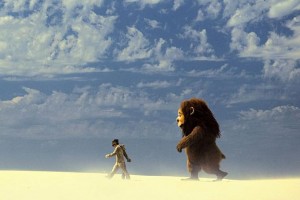 that Max will experience later. It’s natural to imagine the feelings of rejection he experiences from his sister will provide the model for his insecurity with women as he reaches adolescence. This mish-mash of psychology and personality projection works on the level of a dream, meaning interpretations are kaleidoscopic- they change and shift dramatically depending on the angle at which you hold them. Even when the film is pulling from outside of Max’s small, isolated world– say Douglas and Carol’s relationship, which is a classic pairing of the reserved, responsible friend with the impulsive friend– it does so with stunning clarity. The hilariously touchy, often nonsensical flow of conversation between the characters should be familiar to anyone who has observed children speak to one another as well.
that Max will experience later. It’s natural to imagine the feelings of rejection he experiences from his sister will provide the model for his insecurity with women as he reaches adolescence. This mish-mash of psychology and personality projection works on the level of a dream, meaning interpretations are kaleidoscopic- they change and shift dramatically depending on the angle at which you hold them. Even when the film is pulling from outside of Max’s small, isolated world– say Douglas and Carol’s relationship, which is a classic pairing of the reserved, responsible friend with the impulsive friend– it does so with stunning clarity. The hilariously touchy, often nonsensical flow of conversation between the characters should be familiar to anyone who has observed children speak to one another as well.
But really, it’s that rejection of easy simile that makes the film an order of magnitude more complex, timeless, universal, and rewarding.
Is it worth a look? More than a look, this film is worth becoming a life-long, routine title- the kind of movie you break out every year or two like clockwork, and relish any chance to share with someone special to you. It’s one of those masterpieces for which the stars aligned and a ton of brave people worked very hard and put a ton of resources into making a movie with very specific, difficult goals. This could have been a disaster in the other’s hands- few filmmakers have such emotional control over their camera that they could present a film truly from the perspective of a child. This is best evidenced by the way Max observes the behavior of others –his sister guiltily 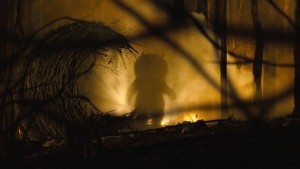 riding away, his mother dealing with professional stress on the phone– and the extremely specific yet universal ideas and feelings they invoke. We understand Mom’s stress without knowing it, we feel the Sister’s internal turmoil without hearing it.
riding away, his mother dealing with professional stress on the phone– and the extremely specific yet universal ideas and feelings they invoke. We understand Mom’s stress without knowing it, we feel the Sister’s internal turmoil without hearing it.
It’s not all sadness and pain though- there’s joy and love and forgiveness in the home and on the island. The dirt clod fight, for example, is a truly spectacular sequence. The sad stuff might be unbearable were Jonze not able to let loose and turn that dirt war into a genuinely exhilarating action scene, or if he failed to capture the wondrous beauty of Carol’s model island.
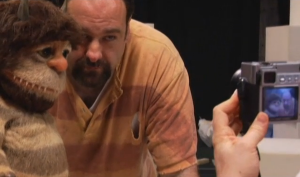 A revisit now is especially apt, as we mourn the passing of the brilliant James Gandolfini. This is unmistakably Max Record’s film, but Gandolfini provides the deepest and richest explorations of loneliness and effervescence. I often refer to Gandolfini’s “mythic gentleness,” which has never been more beautifully let loose than here. You hear the power and wit of Gandolfini’s voice, but there’s never any doubt that he’s a hurt, confused creature capable of great love and loyalty. He is the chaos and calm of Max, the infuriating impulsiveness and the beautiful, joyful abandon all captured in one creature. Gandolfini’s greatness is accentuated by the powerful work from Whitaker, O’Hara, Cooper, Ambrose, and a quietly excellent Paul Dano.
A revisit now is especially apt, as we mourn the passing of the brilliant James Gandolfini. This is unmistakably Max Record’s film, but Gandolfini provides the deepest and richest explorations of loneliness and effervescence. I often refer to Gandolfini’s “mythic gentleness,” which has never been more beautifully let loose than here. You hear the power and wit of Gandolfini’s voice, but there’s never any doubt that he’s a hurt, confused creature capable of great love and loyalty. He is the chaos and calm of Max, the infuriating impulsiveness and the beautiful, joyful abandon all captured in one creature. Gandolfini’s greatness is accentuated by the powerful work from Whitaker, O’Hara, Cooper, Ambrose, and a quietly excellent Paul Dano.
Random Anecdotes: This $100m experiment (which grossed pretty much exactly what it cost) is even more miraculous when you consider how it very nearly didn’t come to be. Adapting Where The Wild Things Are was a persistent goal of several studios for over a decade, with Disney famously testing a CGI/hand-drawn hybrid that never came to pass. Eventually 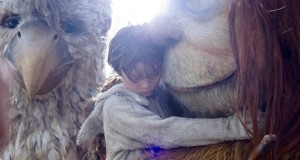 Sendak paired with Jonze, but their first attempt at the turn of the millenium collapsed as well. Even once the WB version was shot, turmoil plagued the production, with testing that said the film was too dark and scary, and rumors abounded that extensive reshoots and even recasting Max Records were on the table. A leak of early test footage did not help matters. Considering WB was delivered exactly the complex, often sad, sometimes scary art house take on a kid’s film they were nervous about, it’s hard to blame them for their nervousness, and, ultimately, the film only made enough money to create a long-term break even scenario for the studio. We must be thankful indeed that they were brave enough to put themselves fully behind the film as Jonze intended it.
Sendak paired with Jonze, but their first attempt at the turn of the millenium collapsed as well. Even once the WB version was shot, turmoil plagued the production, with testing that said the film was too dark and scary, and rumors abounded that extensive reshoots and even recasting Max Records were on the table. A leak of early test footage did not help matters. Considering WB was delivered exactly the complex, often sad, sometimes scary art house take on a kid’s film they were nervous about, it’s hard to blame them for their nervousness, and, ultimately, the film only made enough money to create a long-term break even scenario for the studio. We must be thankful indeed that they were brave enough to put themselves fully behind the film as Jonze intended it.
(Inadequate) Cinematic Soulmates: The NeverEnding Story, Hook, Toy Story 3
